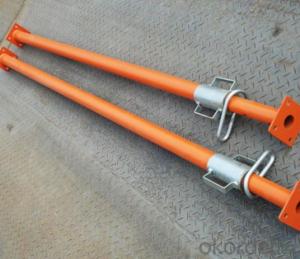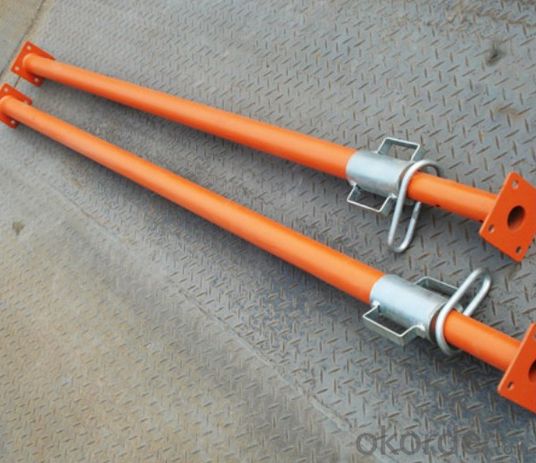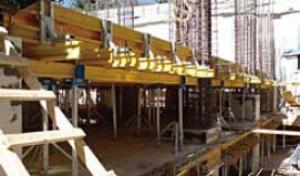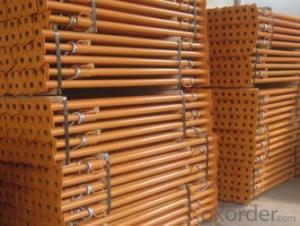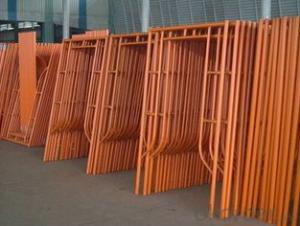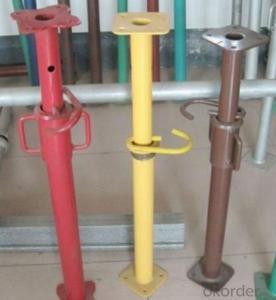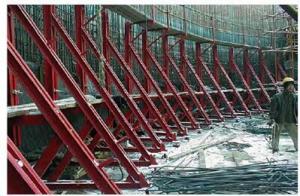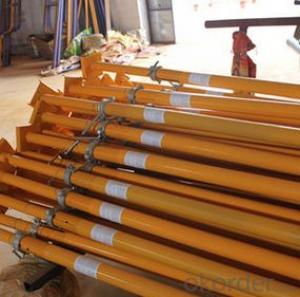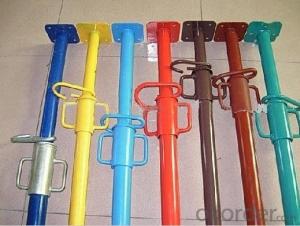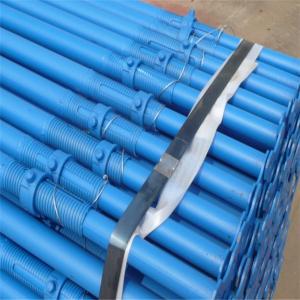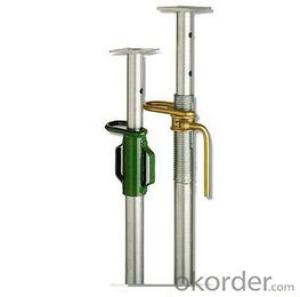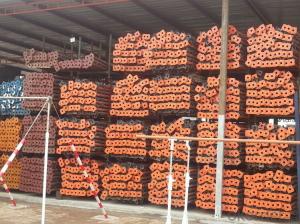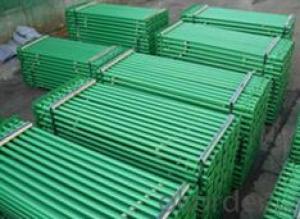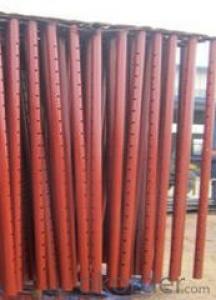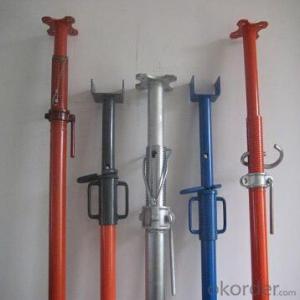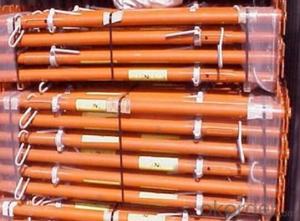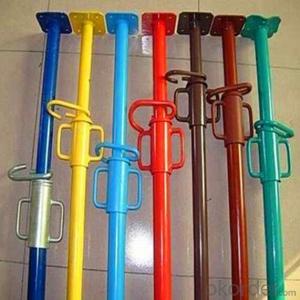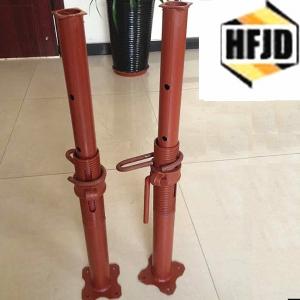steel property Painted scaffolding steel prop
- Loading Port:
- Tianjin
- Payment Terms:
- TT OR LC
- Min Order Qty:
- 10000 PCS
- Supply Capability:
- 10000 PCS/month
OKorder Service Pledge
OKorder Financial Service
You Might Also Like
Quick Details
| Model Number: | Painted prop | ||||
| Material: | Q235,steel | Type: | Adjustable prop | Standard: | BS1139, EN74B |
| Usage: | Scaffolding support | Prop surface: | Painted, Powder coated,Galvanized |
Packaging & Delivery
| Packaging Detail: | Steel pallet Bulk |
| Delivery Detail: | 25days |
Specifications
Painted adjustable prop
1). Scaffolding factory on prop since 1996
2).Prop material in Q235 steel
3).Prop quality ensured,OEM
Adjustable prop,Telescopic prop,Scaffolding painted prop
Professional factory 13 years old with good reputation in scaffolding adjustable prop
Adjustable Prop material: steel Q235, Tube by Cold rolled steel strip, Good loading quality and timely delivery
Prop Adjustable height (Closed – Open):
1.7-3.0M, 1.8-3.2M, 1.9-3.5M, 2.0-3.5M, 2.0-3.6M, 2.1-3.9M, 2.2-3.9M,
2.2-4.0M, 2.4-3.9M, 2.5-3.9M, 2.5-4.5M, 3.5-5.5M, 3.5-6.0M, 3.9-6.0M
Anti-rust coating: Painted,Powder coated, Galvanized
Prop Outer tube available: ¢76mm, ¢70mm, ¢60mm, ¢56mm, ¢48mm
Prop Inner tube available: ¢60mm, ¢48mm, ¢40mm
Thickness available: 1.6mm, 1.8mm, 2.0mm, 2.2mm, 2.5mm, 3.0mm, 3.5mm, 4.0mm
Top/Bottom plate: Flat Square / flower plate, U-head
Loading capacity tested, manufactured to BS4074 and tested to BS5507
OEM is offer
- Q: Can steel props be used for temporary support in wind tunnel construction?
- Yes, steel props can be used for temporary support in wind tunnel construction. Steel props provide strong and stable support, making them suitable for withstanding wind forces during the construction process.
- Q: Can steel props be used for supporting temporary hoardings or barriers?
- Yes, steel props can be used for supporting temporary hoardings or barriers. Steel props are commonly used in construction projects to provide temporary support to structures. They are adjustable and strong, making them suitable for holding up temporary hoardings or barriers.
- Q: Are steel props suitable for supporting walls during demolition?
- Yes, steel props are suitable for supporting walls during demolition. Steel props are strong and durable, making them effective in providing the necessary structural support to prevent collapses during the demolition process. They can be easily adjusted and installed, allowing for flexibility in supporting walls of different sizes and weights.
- Q: Can steel props be used for supporting temporary concert stages or platforms?
- Yes, steel props can be used for supporting temporary concert stages or platforms. Steel props provide strong and stable support, making them suitable for handling heavy loads and ensuring the safety and stability of the stage or platform during concerts or events.
- Q: What is the weight of a standard steel prop?
- The weight of a standard steel prop can vary depending on its size and specifications. On average, a typical steel prop can weigh around 25 to 30 pounds.
- Q: Can steel props be used for supporting elevated walkways and platforms?
- Indeed, elevated walkways and platforms can be supported using steel props. Construction projects frequently employ steel props to offer temporary support and stability to structures. These props are engineered to endure substantial loads and can be effortlessly adjusted to varying heights. With their durability and dependability, steel props prove to be well-suited for supporting elevated walkways and platforms. They guarantee the safety and stability of the structure, establishing a secure foundation for individuals to walk or stand upon.
- Q: The exterior package aluminum plate, with steel support, about how much money.
- General should be between 450-600 yuan / square meters. Only the price in this range, with a real to
- Q: Are steel props commonly used in infrastructure construction projects?
- Yes, steel props are commonly used in infrastructure construction projects. Steel props, also known as adjustable steel props or steel shores, are temporary supports used to provide vertical support to formwork or scaffolding during construction. They are widely used in the construction industry due to their durability, strength, and versatility. Steel props can be easily adjusted to different heights, allowing for flexibility in supporting various structures and loads. They are commonly used in projects involving the construction of bridges, tunnels, buildings, and other infrastructure projects. The use of steel props ensures safety and stability during construction, making them an essential component in infrastructure construction projects.
- Q: Can steel props be used in the construction of historical monuments?
- Yes, steel props can be used in the construction of historical monuments. They provide structural support during restoration or preservation efforts, ensuring the stability and longevity of these important historical structures.
- Q: Are steel props suitable for both indoor and outdoor applications?
- Yes, steel props are suitable for both indoor and outdoor applications. Steel props are durable, weather-resistant, and can withstand various environmental conditions, making them a versatile choice for supporting structures in both indoor and outdoor settings.
Send your message to us
steel property Painted scaffolding steel prop
- Loading Port:
- Tianjin
- Payment Terms:
- TT OR LC
- Min Order Qty:
- 10000 PCS
- Supply Capability:
- 10000 PCS/month
OKorder Service Pledge
OKorder Financial Service
Similar products
Hot products
Hot Searches
Related keywords
